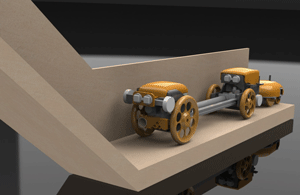

The Djedi Project robot was specifically designed to explore the 8-inch-square shafts in the Great Pyramid of Khufu.
(Courtesy Djedi Team)
Related Articles
How to Build a Pyramid (Feature, May/June '07)
Return to the Great Pyramid (Feature, July/August '09)
Miniature cameras are providing archaeologists with a new way to explore the inaccessible parts of the tombs of two ancient kings, one in Egypt's Great Pyramid of Khufu and another at the Maya city of Palenque in southern Mexico.
In Egypt, a robot carrying a flexible camera made the 213-foot journey through an eight-inch-square shaft that leads from the northern end of the Queen's Chamber. The robot progressed until it was blocked by a limestone "door." The pyramid has a total of four shafts. The ongoing research project is supposed to help scientists figure out what purpose they served, but so far it has only raised new questions. The robot's camera was able to peer through a hole in the door and take photographs revealing two copper pins with curved heads and some hieroglyphic numbers painted about 4,500 years ago in the space between the door and a second piece of limestone that also blocks the shaft. The purpose of the pins and the numbers is still unknown.
In Mexico, beneath a pyramid named Temple 20, a camera was lowered into a tomb through a six-inch-wide hole that was made by archaeologists in 1999. They had not been able to tunnel into the tomb because the temple is unstable. Now, the photographs have revealed that the tomb contains jade and shell artifacts as well as black-on-red wall paintings depicting at least nine figures. The tomb probably belonged to one of the early rulers of the site and dates to roughly 1,500 years ago.
Advertisement

Advertisement







